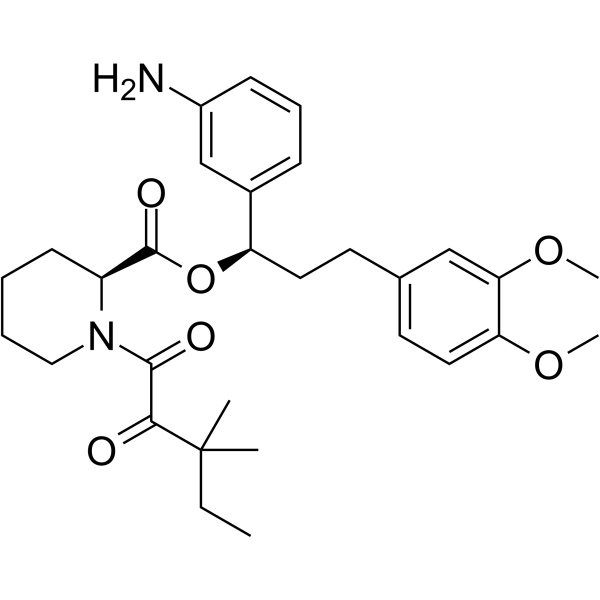Physicochemical Properties
| Molecular Formula | C30H40N2O6 |
| Molecular Weight | 524.65 |
| Exact Mass | 524.288 |
| CAS # | 195513-96-3 |
| Related CAS # | SLF TFA;2378802-47-0 |
| PubChem CID | 35027274 |
| Appearance | Light yellow to yellow ointment |
| Density | 1.2±0.1 g/cm3 |
| Boiling Point | 656.9±65.0 °C at 760 mmHg |
| Flash Point | 351.1±34.3 °C |
| Vapour Pressure | 0.0±2.0 mmHg at 25°C |
| Index of Refraction | 1.559 |
| LogP | 3.63 |
| Hydrogen Bond Donor Count | 1 |
| Hydrogen Bond Acceptor Count | 7 |
| Rotatable Bond Count | 12 |
| Heavy Atom Count | 38 |
| Complexity | 802 |
| Defined Atom Stereocenter Count | 2 |
| SMILES | O([C@@]([H])(C1C([H])=C([H])C([H])=C(C=1[H])N([H])[H])C([H])([H])C([H])([H])C1C([H])=C([H])C(=C(C=1[H])OC([H])([H])[H])OC([H])([H])[H])C([C@]1([H])C([H])([H])C([H])([H])C([H])([H])C([H])([H])N1C(C(C(C([H])([H])[H])(C([H])([H])[H])C([H])([H])C([H])([H])[H])=O)=O)=O |
| InChi Key | IIDSDBBDZNDWCN-BJKOFHAPSA-N |
| InChi Code | InChI=1S/C30H40N2O6/c1-6-30(2,3)27(33)28(34)32-17-8-7-12-23(32)29(35)38-24(21-10-9-11-22(31)19-21)15-13-20-14-16-25(36-4)26(18-20)37-5/h9-11,14,16,18-19,23-24H,6-8,12-13,15,17,31H2,1-5H3/t23-,24+/m0/s1 |
| Chemical Name | [(1R)-1-(3-aminophenyl)-3-(3,4-dimethoxyphenyl)propyl] (2S)-1-(3,3-dimethyl-2-oxopentanoyl)piperidine-2-carboxylate |
| HS Tariff Code | 2934.99.9001 |
| Storage |
Powder-20°C 3 years 4°C 2 years In solvent -80°C 6 months -20°C 1 month |
| Shipping Condition | Room temperature (This product is stable at ambient temperature for a few days during ordinary shipping and time spent in Customs) |
Biological Activity
| ln Vitro | The three fused scout fragments, KB02, KB03, and KB05, exhibit broad cysteine reactivity in the human proteome and cover two distinct electrophile groups (chloroacetamide and acrylamide). These fragments bind tightly and selectively to the SLF ligand, which is bound to the cytosolic prolyl isomerase FKBP12, which has been widely employed in research on ligand-induced protein degradation[3]. |
| References |
[1]. FKBP Ligands-Where We Are and Where to Go? Front Pharmacol. 2018 Dec 5;9:1425. [2]. Creating diverse target-binding surfaces on FKBP12: synthesis and evaluation of a rapamycin analogue library. ACS Comb Sci. 2011 Sep 12;13(5):486-95. [3]. Electrophilic PROTACs that degrade nuclear proteins by engaging DCAF16. Nat Chem Biol. 2019 Jul;15(7):737-746. |
Solubility Data
| Solubility (In Vitro) | DMSO : 100 mg/mL (190.60 mM) |
| Solubility (In Vivo) |
Solubility in Formulation 1: ≥ 2.08 mg/mL (3.96 mM) (saturation unknown) in 10% DMSO + 40% PEG300 + 5% Tween80 + 45% Saline (add these co-solvents sequentially from left to right, and one by one), clear solution. For example, if 1 mL of working solution is to be prepared, you can add 100 μL of 20.8 mg/mL clear DMSO stock solution to 400 μL PEG300 and mix evenly; then add 50 μL Tween-80 to the above solution and mix evenly; then add 450 μL normal saline to adjust the volume to 1 mL. Preparation of saline: Dissolve 0.9 g of sodium chloride in 100 mL ddH₂ O to obtain a clear solution. Solubility in Formulation 2: ≥ 2.08 mg/mL (3.96 mM) (saturation unknown) in 10% DMSO + 90% Corn Oil (add these co-solvents sequentially from left to right, and one by one), clear solution. For example, if 1 mL of working solution is to be prepared, you can add 100 μL of 20.8 mg/mL clear DMSO stock solution to 900 μL of corn oil and mix evenly. (Please use freshly prepared in vivo formulations for optimal results.) |
| Preparing Stock Solutions | 1 mg | 5 mg | 10 mg | |
| 1 mM | 1.9060 mL | 9.5302 mL | 19.0603 mL | |
| 5 mM | 0.3812 mL | 1.9060 mL | 3.8121 mL | |
| 10 mM | 0.1906 mL | 0.9530 mL | 1.9060 mL |
